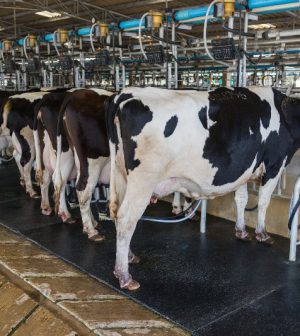- Navigating Your Midlife Crisis: Embracing New Possibilities
- City Raccoons Showing Signs of Domestication
- Mapping the Exposome: Science Broadens Focus to Environmental Disease Triggers
- One Week Less on Social Media Linked to Better Mental Health
- Your Brain Changes in Stages as You Age, Study Finds
- Some Suicide Victims Show No Typical Warning Signs, Study Finds
- ByHeart Formula Faces Lawsuits After Babies Sickened With Botulism
- Switch to Vegan Diet Could Cut Your Greenhouse Gas Emissions in Half
- Regular Bedtime Does Wonders for Blood Pressure
- Dining Alone Could Mean Worse Nutrition for Seniors
Texan Has Contracted H5N1 Bird Flu; CDC Calls Threat to Public ‘Low’

An unnamed person in Texas had been diagnosed with the H5N1 avian flu after close contact with infected dairy cattle, the U.S. Centers for Disease Control and Prevention reported Monday.
It’s only the second case ever confirmed in the United States (the first was in Colorado in 2022), and preliminary analysis of the strain in the new case suggests no new mutations of concern.
“This infection does not change the H5N1 bird flu human health risk assessment for the U.S. general public, which CDC considers to be low,” the agency said in a statement.
According to the CDC, the person was diagnosed with infection after prolonged contact with dairy cattle “presumed to be infected with HPAI A[H5N1] viruses.”
The patient’s illness so far has been mild: The only symptom is conjunctivitis (redness) of the eye.
“The patient was told to isolate and is being treated with an antiviral drug for flu,” the CDC said.
Human cases of H5N1 are rare but do occur sporadically worldwide, the CDC noted.
And it’s perhaps unsurprising that such a case occurred in Texas, since H5N1 avian flu has surged among livestock there this year.
In dairy cows, it “was first reported in Texas and Kansas by the U.S. Department of Agriculture [USDA] on March 25, 2024,” the CDC said. “Unpasteurized milk from sick cattle collected from two dairy farms in Kansas and one in Texas, as well as a throat swab from a cow in another dairy in Texas, tested positive” for the virus.
On March 29, infection was also found among a herd of dairy cows in Michigan that had received cows from Texas, the agency noted.
Importantly, the Texas Department of State Health Services noted in an alert that cattle infections “do not present a concern for the commercial milk supply. Dairies are required to destroy or divert milk from any sick cows, plus pasteurization kills avian flu viruses.”
Still, the CDC has been tracking the spread of avian flu since outbreaks were first reported among wild and domesticated birds in the United States back in 2021.
While the emergence of a strain of bird flu that has the ability to transmit easily between humans is of paramount concern, cases in humans so far have typically arisen only in people who’ve had close exposures to infected animals.
Circulating strains of H5N1 also appear to be easily treatable using standard antivirals.
“Preliminary analysis of A[H5N1] viruses has not found changes that would make these viruses resistant to current FDA-approved flu antiviral medications, so these are believed to be effective against these viruses,” the CDC said.
As for the human case in Texas, “CDC is working with state health departments to continue to monitor workers who may have been in contact with infected or potentially infected birds/animals and test those people who develop symptoms,” the agency said.
Should the virus ever mutate to spread easily among humans, the CDC says vaccines have been developed that should “provide reasonable protection against H5N1 influenza viruses.” The current seasonal flu vaccine would not help prevent infection with avian flu.
While the current threat to the public is low, the CDC said it continues to monitor H5N1 viruses nationally.
“This is a developing situation, and CDC will share additional updates as new relevant information becomes available,” the agency said.
In the meantime, the CDC says the odds of contracting avian flu can be diminished by reducing contact with live or dead animals, such as “wild birds, poultry, other domesticated birds, and other wild or domesticated animals [including cattle].”
Another big tip to avoiding H5N1: Stay away from unpasteurized milk products. That includes “raw” milk, cheeses and other such foods, the CDC said.
“FDA’s longstanding position is that unpasteurized, raw milk can harbor dangerous microorganisms that can pose serious health risks to consumers, and FDA is reminding consumers of the risks associated with raw milk consumption in light of the HPAI detections,” the agency said.
More information
Find out more about H5N1 avian flu at the World Health Organization.
SOURCE: U.S. Centers for Disease Control and Prevention, statement, April 1, 2024; Texas Department of State Health Services, news release, April 1, 2024
Source: HealthDay
Copyright © 2025 HealthDay. All rights reserved.










